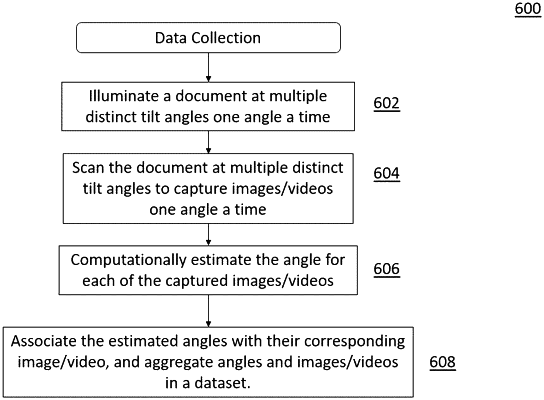| CPC G06V 10/145 (2022.01) [G06V 10/225 (2022.01); G06V 10/774 (2022.01); G06V 30/413 (2022.01)] | 21 Claims |

|
1. A computer-implemented method of authenticating documents, comprising:
capturing, sequentially at a first set of placement angles that are different from each other, a first set of photo images of one or more security features of a known authentic document that is placed under an illumination condition, and wherein the one or more security features, when illuminated, are visible, partially or fully, at the first set of placement angles;
for each of the first set of photo images, estimating, by using a computer-implemented machine learning algorithm, an angle of the known authentic document being held at the time when the photo image was captured, and aggregating the angle in association with the photo image of the first set of photo images into a first set of estimated angles, and storing the first set of estimated angles along with the first set of photo images;
training a computer vision algorithm to learn and model a set of document's angular responses of a document genre under the illumination condition based on the first set of photo images and the first set of estimated angles, wherein the training deduces at least one piece of descriptive information about each security feature of the one or more security features based on the first set of photo images and the first set of estimated angles, and produces a learned model encoded with the set of document's angular responses of the document genre under the illumination condition that contains the at least one piece of descriptive information about each security feature of the one or more security features;
capturing, sequentially at a second set of placement angles that are different from each other a second set of photo images of a security feature of a first unknown document that is placed under the illumination condition, and wherein the first unknown document is of the document genre and whose authenticity is to be determined;
for each of the second set of photo images, estimating, by using the computer-implemented machine learning algorithm, an angle of the first unknown document being held at the time when the photo image was captured, and aggregating the angle in association with the photo image of the second set of photo images into a second set of estimated angles, and storing the second set of estimated angles along with the second set of photo images; and
determining the authenticity of the first unknown document by applying the learned model on the second set of photo images and the second set of estimated angles, wherein the applying the model at least involves comparing a piece of descriptive information about the security feature of the first unknown document that is encoded in the learned model as a part of the set of document's angular responses of the document genre under the illumination condition, with a piece of information about the security feature of the first unknown document extracted from the second set of the photo images and the second set of estimated angles, wherein the comparing step produces a first confidence value, and if the first confidence value is below a pre-determined confidence threshold, the first unknown document is determined to be unauthentic, otherwise the first unknown document is determined to be authentic with regard to the security feature of the first unknown document.
|